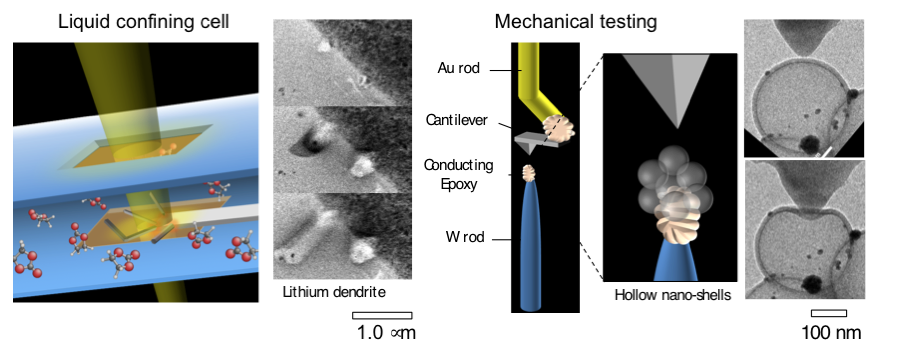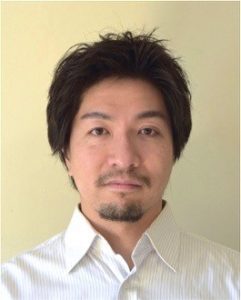Education
- Ph.D. — Engineering Physics and Mechanics, Kyoto University, 2007
- M.E. — Engineering Physics and Mechanics, Kyoto University, 2004
- B.E. — Engineering Science, Kyoto University, 2002
Research
- In-situ transmission electron microscopy
- Atomistic simulation
- Nano-characterization
- Nano-mechanics
- Energy-storage materials
Dr. Kushima’s research focuses on understanding the complex nano-scale phenomena through combination of experiment and atomistic simulation, with particular emphasis on in-situ transmission electron microscopy (TEM) and energy storage devices. Nanotechnology is an inextricable part of our modern everyday life. Nano-characterization technique such as in situ TEM is a powerful tool to understand the materials from atomic scales and contribute to advancement of the technology. It enables us to “see” atomic-scale behavior of materials in real time, and atomistic simulation provides theoretical understanding to the observation. These two approaches together will be used to elucidate the underlining mechanisms of the complex phenomena.
Lithium ion battery is one of the leading candidates because of their high gravimetric/volumetric capacity and the high power. However, there is a large room for improvement. For example, the most commonly used anode material is graphite, but nano-structured electrodes have potentials to significantly enhance the battery capacity by enabling the use of high capacity materials. Here, insights obtained from in situ TEM experiment and atomistic modeling can be directly linked to their performance and contribute to developing novel electrode materials. Another important factor that affects the battery performance is the reaction at the electrode-electrolyte interface. The battery electrolyte decomposes at the surface of the electrode forming a solid electrolyte interface (SEI) layer. The SEI passivates the surface and prevents further decomposition of the electrolyte. However, large volume change of the electrode can cause the SEI layer to fracture and the electrolyte continues to decompose at the freshly exposed electrode surface. To understanding the formation mechanism of the SEI (thickness in orders of nm), in-situ TEM experiment is conducted using liquid-confining cell. The cell has electron beam transparent membrane windows and confines the liquid electrolyte without evaporating it inside TEM.
The in-situ TEM technique is not only valuable for testing energy storage materials, but also have various potential application. In addition to the lithium ion battery, Dr. Kushima is developing techniques to observe the materials deformation processes in nano-scale (tension, tribology, fatigue, etc.) and evaluate the mechanical properties. Additionally, the liquid confining cell can be potentially used for other fields where interaction with liquid/gas is important such as fuel cells, corrosions, and cell biology.

Selected Publications
- A. Kushima, K. P. So, C. Su, P. Bai, N. Kuriyama, T. Maebashi, Y. Fujiwara, M. Z. Bazant, J. Li, “Liquid cell transmission electron microscopy observation of lithium metal growth and dissolution: Root growth, dead lithium and lithium flotsams”, Nano Energy, 32, 271 (2017).
- G. Xu, Q. Yan, A. Kushima, X. Zhang, J. Pan, and J. Li, “Conductive graphene oxide-polyacrylicacid (GOPAA) binder for lithium-sulfur battery”, Nano Energy, 31, 568 (2017).
- Y. Jin, S. Li, A. Kushima, X. Zheng, Y. Sun, J. Xie, J. Sun, W. Xue, G. Zhou, J. Wu, F. Shi, R. Zhang, Z. Zhu, K. So, Y. Cui, and J. Li, “Self-healing SEI enables full-cell cycling of a silicon-majority anode with a coulombic efficiency exceeding 99.9%”, Energy Environ. Sci., DOI: 10.1039/C6EE02685K
- Z. Zhu, A. Kushima, Z. Yin, L. Qi, K. Amine, J. Lu, and J. Li, “Anion-redox nanolithia cathodes for Li-ion batteries”, Nature Energy, 1, 16111 (2016).
- K. P. So, X. Liu, H. Mori, A. Kushima, J. G. Park, H. S. Kim, S. Ogata, Y. H. Lee, and J. Li, “Ton-scale metal-carbon nanotube composite: The mechanism of strengthening while retaining tensile ductility”, Extreme Mech. Lett., 8, 245 (2016).
- K. P. So, D. Chen, A. Kushima, M. Li, S. Kim, Y. Yang, Z. Wang, J. G. Park, Y. H. Lee, R. I. Gonzalez, M. Kiwi, E. M. Bringa, L. Shao, and Ju Li, “Dispersion of carbon nanotubes in aluminum improves radiation resistance”, Nano Energy, 22, 319 (2016).
- A. Kushima, T. Koido, Y. Fujiwara, N. Kuriyama, N. Kusumi, and J. Li, “Charging/Discharging Nanomorphology Asymmetry and Rate-Dependent Capacity Degradation in Li–Oxygen Battery”, Nano Lett., 15, 8260 (2015).
- C. Wang, X. Wang, Y. Yang, A. Kushima, J. Chen, J. Li, Y. Huang, “Slurryless Li2S/Reduced Graphene Oxide Cathode Paper for High-Performance Lithium Sulfur Battery”, Nano Lett., 15, 1796 (2015).
- A. Kushima, X. Qian, P. Zhao, S. Zhang, and J. Li, “Ripplocations in van der Waals Layers”, Nano Lett., 15, 1302 (2015).
- J. Niu, A. Kushima, M. Li, Z. Wang, W. Li, and J. Li, “Scalable Synthesis of Sulfur NanospongeCathode for Lithium-Sulfur Battery with Improved Cyclability”, J. Mater. Chem. A., 2, 19788 (2014).
- Niu*, A. Kushima*, X. Qian, L. Qi, K. Xiang, Y. -M. Chiang, and J. Li, “In Situ Observation of Random Solid Solution Zone in LiFePO4 Electrode”, Nano Lett., 14, 4005 (2014). *equal contribution
- M. Gu, A. Kushima, Y. Shao, J. -G. Zhang, J. Liu, N. D. Browning, J. Li, and C. Wang, “Probing the Failure Mechanism of SnO2 Nanowires for Sodium-Ion Batteries”, Nano Lett., 13, 5203, (2013).
- Y. Zhu, J. W. Wang, Y. Liu, X. H. Liu, A. Kushima, Y. Liu, Y. Xu, S. X. Mao, J. Li, C. Wang, J. Y. Huang, “In Situ Atomic-Scale Imaging of Phase Boundary Migration in FePO4 Microparticlesduring Electrochemical Lithiation”, Adv. Mater., 25, 5461, (2013).
- J. Y. Huang, Y. -C. Lo, J. J. Niu, A. Kushima, X. Qian, L. Zhong, S. Mao, and J. Li, “Nanowire Liquid Pumps”, Nature Nanotech., 8, 277 (2013).
- A. Kushima, J. Y. Huang, and J. Li, “Quantitative Fracture Strength and Plasticity Measurements of Lithiated Silicon Nanowires by In Situ TEM Tensile Experiments”, ACS Nano, 6, 9425 (2012).
- Y. Fan, A. Kushima, S. Yip, and B. Yildiz, ”Comment on "Mechanism of Void Nucleation and Growth in bcc Fe: Atomistic Simulations at Experimental Time Scales" Reply”, Phys. Rev. Lett., 108, 219602 (2012).
- X. H. Liu, Y. Liu, A. Kushima, S. Zhang, T. Zhu, J. Li, and J. Y. Huang, “In Situ TEM Experiments of Electrochemical Lithiation and Delithiation of Indivisual Nanostructures”, Adv. Energy Mater, 2, 722 (2012).
- X. H. Liu, J. W. Wang, Y. Liu, H. Zheng, A. Kushima, S. Huang, T. Zhu, S. X. Mao, J. Li, S. Zhang, W. Lu, J. M. Tour, and J. Y. Huang, “In Situ Transmission Electron Microscopy of Electrochemical Lithiation, Delithiation and Deformation of Individual Graphene Nanoribbons”, Carbon, 50, 3836 (2012).
- A. Kushima, X. H. Liu, G. Zhu, J. Li, Z. L. Wang, and J. Y. Huang, “Leapfrog cracking and nano-amorphization of ZnO nanowire during in-situ electrochemical lithiation”, Nano Lett., 11, 4535 (2011).
- A. Kushima, J. Eapen, J. Li, S. Yip, and T. Zhu, “Time scale bridging in atomistic simulation of slow dynamics: viscous relaxation and defect activation”, E. Phys. J. B, 82, 271 (2011).
- Y. Liu, H. Zheng, X. H. Liu, T. Zhu, J. Wang, A. Kushima, N. S. Hudak, X. Huang, S. Zhang, S. X. Mao, X. Qian, J. Li, and J. Y. Huang, “Lithiation-induced embrittlement of multiwalledcarbon nanotubes”, ACS Nano, 5, 7245 (2011).
- X. H. Liu, H. Zheng, L. Zhong, S. Huang, K. Karki, L. Q. Zhang, Y. Liu, A. Kushima, W. T. Liang, J. W. Wang, J. -H. Cho, E. Epstein, S. A. Dayeh, S. T. Picraux, T. Zhu, J. Li, J. P. Sullivan, J. Cumings, C. Wang, S. X. Mao, Z. Z. Ye, S. Zhang, and J. Y. Huang, “Anisotropic swelling and fracture of silicon nanowire during lithiation”, Nano Lett., 11, 3312 (2011).
- J. Li, A. Kushima, J. Eapen, X. Lin, X. Qian, J.C. Mauro, P. Diep, S. Yip, “Computing the viscosity of supercooled liquids: Markov network model,” PLoS ONE, 6, e17909 (2011).
- Y. Fan, A. Kushima, S. Yip, and B. Yildiz, “Mechanism of void nucleation and growth in bcc Fe: Atomistic simulations at experimental time scales”, Phys. Rev. Lett., 106, 125501 (2011).
- X. H. Liu, L. Zhong, L. Q. Zhang, A. Kushima, S. X. Mao, J. Li, Z. Z. Ye, J. P. Sullivan, and J. Y. Huang, “Lithium fiber growth on the anode in a nanowire lithium ion battery during charging”, Appl. Phys. Lett., 98, 183107 (2011).
- A. Kushima, D. Parfitt, A. Chroneos, B. Yildiz, J. A. Kilner, and R. W. Grimes, “Interstitialcydiffusion of oxygen in tetragonal La2CoO4+δ”, Phys. Chem. Chem. Phys., 13, 2242 (2011).
- J. Huang, L. Zhong, C. M. Wang, J. P. Sullivan, W. Xu, L. Q. Zhang, S. X. Mao, N. S. Hudak, X. H. Liu, A. Subaramanian, H. Fan, L. Qi, A. Kushima, J. Li, “In-situ observation of the electrochemical lithiation of a single SnO2 nanowire electrode”, Science, 330, 1515 (2010).
- A. Kushima, S. Yip and B. Yildiz, “Competing strain effects in reactivity of LaCoO3 with oxygen”, Phys. Rev. B, 82, 115435 (2010).
- A. Kushima and B. Yildiz, “Oxygen ion diffusivity in strained yttria stabilized zirconia: where is the fastest strain?”, J. Mater. Chem., 20, 4809 (2010).
- T. T. Lau, A. Kushima, and S. Yip, “Atomistic simulation of creep in nanocrystal”, Phys, Rev. Lett., 104, 175501 (2010).
- A. Kushima, X. Lin, and S. Yip, “Commentary on the temperature-dependent viscosity of supercooled liquids: a unified activation scenario”, J. Phys.: Condens. Matter, 21, 504104 (2009).
- R. J. -M. Pellenq, A. Kushima, R. Shahsavari, K. J. Van Vliet, M. J. Buehler, S. Yip, and F. -J. Ulm, “A realistic molecular model of cement hydrates”, Proc. Natl. Acad. Sci. USA, 106, 16 102 (2009).
- Y. Fan, A. Kushima, and B. Yildiz, “Unfaulting mechanism of self-interstitial atom clusters in bcc Fe: A kinetic study based on the potential landscape”, Phys. Rev. B 81, 104102 (2010).
- A. Kushima and B. Yildiz, “Role of Lattice Strain and Defect Chemistry on the Oxygen Vacancy Migration at the (8.3% Y2O3-ZrO2)/SrTiO3 Hetero-Interface: A First Principles Study”, ECS Trans. 25, 1599 (2009).
- A. Kushima, X. Lin, J. Li, X. Qian, J. Eapen, J. C. Mauro, P. Diep, and S. Yip, “Computing the viscosity of supercooled liquids. II. Silica and strong-fragile crossover behavior”, J. Chem. Phys., 131, 164505 (2009).
- A. Kushima, X. Lin, J. Li, J. Eapen, J. C. Mauro, X. Qian, P. Diep, and S. Yip, “Computing the viscosity of supercooled liquids”, J. Chem. Phys., 130, 224504 (2009).
- T. Lau, A. Kushima, and S. Yip, “An atomistic method for slow structural deformations”, Mater. Sci. Eng., 3, 012002 (2009).
- A. Kushima, Y. Umeno, and T. Kitamura, “Ideal strength of a Cu multi-shell nano-wire”, Modelling Simul. Mater. Sci. Eng., 14, 1031 (2006).
- Y. Umeno, A. Kushima, T. Kitamura, P. Gumbsch, and J. Li, “Ab initio study of the surface properties and ideal strength of (100) silicon thin films”, Phys. Rev. B 72, 165431 (2005).
- T. Kitamura, Y. Umeno, A. Kushima, “Ideal strength of nano-components”, Mater. Sci. Forum, 483, 25 (2005).
- Y. Umeno, T. Kitamura, and A. Kushima, “Metallic-semiconducting transition of single-walled carbon nanotubes under high axial strain”, Comput. Mater. Sci., 31, 33 (2004).
- Y. Umeno, T. Kitamura, and A. Kushima, “Theoretical analysis on electronic properties of zigzag-type single-walled carbon nanotubes under radial deformation”, Comput. Mater. Sci., 30, 283 (2004).

